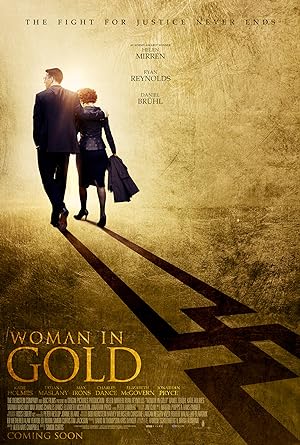Woman in Gold is a lush, visual masterpiece that effectively uses well-worn narrative devices to create an emotionally resonant story. Woman in Gold is about when Maria Altmann, a Jewish-Viennese refugee who moved to the US during WWII to escape the Holocaust, finally decides in her twilight years to reclaim her family’s property, which includes Gustav Klimt’s Portrait of Adele Bloch-Bauer I. The Nazis, in concert with the Austrian government, seized the property, but the Austrian government kept it long after the Nazis’ defeat. She enlists the help of a lawyer and family friend, who is the grandson of notable Jewish-Austrian refugees.
I normally hate movies that use the courtroom as a plot device to create resolution, but in this case, it happened and was necessary. Woman in Gold intersperses present scenes with flashbacks of the Altmann’s family’s glorious past and sudden encounter with cruelty, indignity and oppression. By juxtaposing the past with the present, Woman in Gold indicts the Austrian government for not immediately handing everything back and continuing a horrifying legacy except instead of being predominantly motivated by hate, it is still motivated by greed and nationalism. Austria erases Jewish identity by privileging the Austrian interpretation of events and administration of government and law.
Normally creating a character that wants to provide for his family is tedious-everyone wants to provide for their family. You’re not special. In Woman in Gold, it works because by creating another generation and becoming financially stable, it is another moment of success and survival that could have been eradicated ages ago. The only negative of that portrait was that I didn’t buy that he would not be more sensitive regarding why Maria would obviously not want to return to Vienna. I don’t care if my family is from the Caribbean, and I intellectually know that the Southern half of the US is not what it once was, I’m reluctant to go there.
I understand that Woman in Gold is a drama based on a real story so some scenes may be exaggerated, but two scenes really affected me: first, when Maria and her husband receive casual and swift kindness from an anonymous woman hanging up her wet clothes on a clothesline in an alley and when the older Maria decides to walk alone in Vienna after she returns for the first time since she escaped and receives a casual and callous comment from an anonymous man. We never know the motivations of these characters, but their words and actions speak volumes.
Woman in Gold has a great cast. Helen Mirren is amazing as always, but Tatiana Maslany is one of the best and most versatile actresses of our time so I’m glad that she got a little mainstream exposure. While Ryan Reynolds did a great job, I’m a little disappointed that a Jewish actor didn’t get a chance to play the role of Randy Schoenberg. I love Katie Holmes, who basically gets to play the supportive and eternally pregnant wife, but our latest Catholic actress who escaped Scientology doesn’t get much to do here. I’d love to know if that frustrated the real Pamela Mayers-Schoenberg, who seems to be a notable Jewish artist and probably played a more pivotal role in her lawyer husband’s art education than simply being a cheerleader. I wanted more time to enjoy the brief, but excellent, elegant and haunting performance of Antje Traue as the titular character.
Woman in Gold is a must see for art lovers, history buffs or anyone who just likes to see a just, happy ending.
Stay In The Know
Join my mailing list to get updates about recent reviews, upcoming speaking engagements, and film news.




